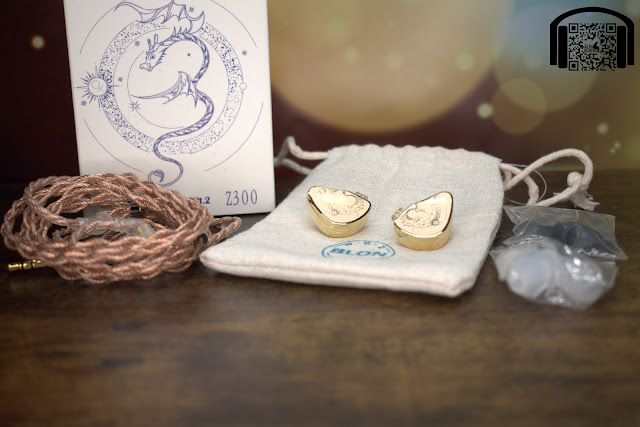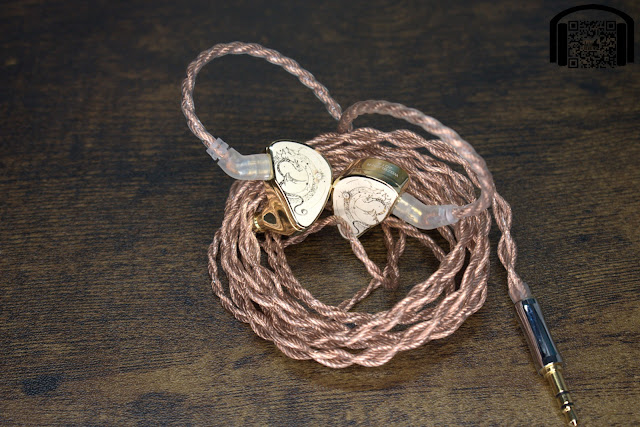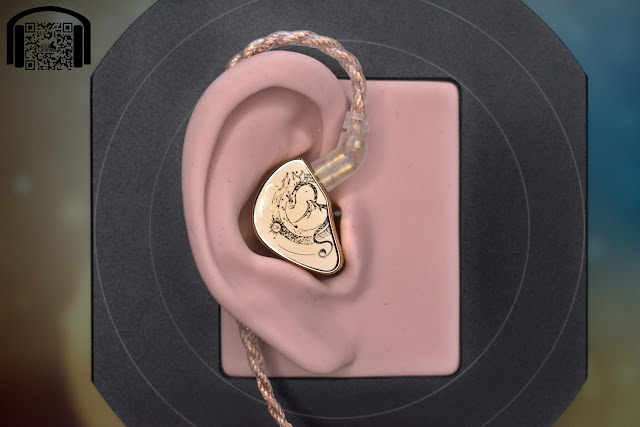Blon x HBB Z300
TLDR version on YouTube: TDLR - Blon x HBB Z300
The Blon Z300 have been sent to me by Linsoul in exchange for the publication of this review. Linsoul have made no specific requests or comments and, as always, I will do my best to be as unbiased and sincere as humanly possible.
I will leave a link to the Z300 via Linsoul on my blog, which you can access by following the link at the end of this review.
(As with all links I share, this is a non-affiliate link).
To avoid being repetetive in my reviews, you can find all the info about how I create the reviews, equipment used, how I receive the products and how to interpret my reviews by visiting: About my reviews
Intro…
So we have another collaboration, once again by HBB (of Bad Guy Good Audio Reviews) but this time with Blon. I have actually lost count of how many collabs there have been by HBB but I know that there are a lot ![]()
Honestly, while I have understood the appeal of previous HBB tunings to a vast amount of people, I haven’t really fallen in love with any of them. I think that, out of the ones I have tried, the KAI was probably my favourite. It is not that I think the others have been bad, they just don’t suit my personal tastes, usually due to an excessive presence in the lower ranges.
Upon receiving the Z300, I had (have) quite a backlog of stuff but for some reason it ended up in my bag and when I arrived at the office after a long weekend, it was the only set I had with me. So, I decided to give it a whirl (jumping the queue of other items) and I have to say, the first listen was impressive.
Usually I put all new arrivals on the burn in rig for at least 150 hours, not because I am a strong believer in burn in but because it doesn’t cost me anything to do so while they wait their turn. In this case, no burn in was done (![]() ) but I really don’t think that should be a concerning factor for those who feel it is necessary, as my opinions are positive, so unless it was supposed to get worse…
) but I really don’t think that should be a concerning factor for those who feel it is necessary, as my opinions are positive, so unless it was supposed to get worse… ![]()
Anyhow, the Blon Z300 costs around 30€ at the time of putting together this review, placing it firmly in the ultra budget category (that I consider under 50€) and, in my opinion, it places high in the ranking of said budget IEMs, competing with some of my favourite IEMs in this price bracket, such as the Kiwi Ears Cadenza.
So, let me try and explain what makes me like the Z300 and how I find it to perform.
Presentation…
There is really nothing spectacular about the presentation of the Z300, as is usual with Blon, and it really shouldn’t be expected at this price range anyway.
A simple white box with slide out tray is the packaging used, with a monochromatic image of a dragon on the front and the text “Oppoty & Driams Pt.2”. While the majority will know what this refers to, for the newcomers to the IEM world, “Oppoty & Driams” was the caption which became famous with the release of the Blon BL03, a set of IEMs that received a huge amount of praise and set the bar of ultra budget IEMs at a new level at the time (if you could get them to fit that was). Later Blon obviously found spell check and the well known catchphrase was dropped.
Funny thing is that, in my opinion, Blon really hasn’t done anything worthy of high praise since the “Oppoty & Driams” was dropped, and the return of this slogan with a set that is actually worth praise is very fitting.
But anyway, I digress…
Inside the box we get the IEMs, the cable, a small drawstring bag (like a miniature potato sack, another Blon clasic) and 6 sets of silicone tips in two types. Blon have never really been great with their tips and usually I don’t even bother to use them on the sets that I receive but, as these were the only IEMs I had with me, I used them for the first day and either my memory is fading or these are actually better than those of yesteryear (at least the white ones).
As far as contents and packaging, that is all we get but it has inspired a trip down memory lane ![]()
Build and aesthetics…
The build uses a zinc alloy shell which is published as being 18K gold-plated. I have no idea if they are gold-plated or not but they are certainly very gold, at least the model I received. The IEMs are available in two colours, blue and gold, and luck would have it that I received the gold version (I am not really a fan of gold).
However, I have to say that the aesthetics are very good and judging by the photos, I think the blue may be even more impressive in person.
The build seems to be very well done, with no apparent issues on my set and while I don’t know how the gold finish will hold up, I can do nothing but praise these IEMs for build and aesthetics at this price range.
Comfort is also very good for me personally, without the issues of some of the previous Blon models (which actually were ok for me but were problematic for many). They are lightweight and the shape fits well, meaning I experienced no discomfort even after hours of wearing them.
Last but not least, the cable. It is nothing extraordinary but it is a good cable that is far better than some of the cables received with IEMs that cost 10 times or more than the Z300. I have absolutely no complaints about it so, as far as build and aesthetics in general, full praise in this category from me.
Sound…
All tracks mentioned are clickable links that allow you to open the reference track in the streaming service of your choice (YouTube, Tidal, Qobuz, Spotify, etc.)
As I mentioned previously, I didn’t intend to review these IEMs. Even when I put them on originally, my intention was to use them for the day and then take them home and throw them on the burn in rig until it was their turn. Yet, straight away I found myself enjoying the music and ended up spending all week with them. This is already positive from my side as I found I enjoyed them and didn’t just “have” to use them to review them (which does happen with many sets).
Over the week I have listened to plenty of genres of music, finding them to be a pleasurable listen with almost all of them. Yes, there have been certain tracks/albums where I found them to be a little too warm and even too bassy on occasions, but those have been limited to certain things and not the majority (like with some of the other HBB collabs).
But let’s get on with my usual process using my normal detailed listening playlist (which can be found in full on my blog BTW) and starting off, as usual with the graph in comparison to my personal preference target.
I have said many times before that my reference target is just as a guide, it is not an indication that I will definitely like or dislike something, many other factors come into play. In fact, the Z300 graphs very similarly to some other models that I have enjoyed (and some that I haven’t). You can see how it compares to other IEMs by visiting the Acho Reviews Squig Link (link at the end of this review).
So… starting off with the subbass and my usual (almost obligatory) workout with “Chameleon”, we get off to a fairly good start. The lowest notes do not present as much rumble as on some other sets yet there is still more than enough for the track to be appreciated for what it is. The subbass is also clean and nicely defined, as far as subbass goes, showing the subtleties of these notes in tracks like “Royals”.
In the midbass range, there is a bit of a boost above what would be my personal preference, however, as the bass range is well controlled, keeping notes fast when they need to be and without interfering with other sounds happening around them, I find the midbass to be quite enjoyable.
Anyone who has followed my reviews over time will know that excessive and uncontrolled midbass is something that fatigues me, even causing me to feel nauseous at times. My quick test for this is “Crazy” by Daniela Andrade, where the low end of the guitar can become a uncontrolled and overly reverberant, something that is not the case with the Z300. Yes, there is still a trace of it being overly boosted but I don’t find it to affect me negatively like it does on so many other sets.
Knowing that HBB has a library that consists of a lot of rock, and that I have found many of his other collaborations to be overly boosted in these ranges for my personal preference as far as rock bass is concerned, I found the bass guitar in “Whole Lotta Love” to be nicely present in the tuning of the Z300. There is a presence that gives it a bit of warmth but still keeps the notes clear and precise in this rather old recording. The same can be said for the bass guitar in “Bombtrack”, although I did find the kick drum to be a little too present on this track. I am really being picky here and the air that the kick drum moves is impressive, without even considering price.
Focusing on something more electronic, such as “Sun Is Shining”, I think the bass range works fairly well and while it may not be enough for those who like skull rattling bass, personally I feel it has a decent balance with the rest of frequencies to place the focus on those bass notes without taking over the whole spectrum.
Moving on to the mid range, I find that acoustic guitars and other similar instruments have a nice timbre to them, seeming very realistic with just a hint of extra warmth. The lower ranges of vocals, particularly deep male vocals such as Leonard Cohen in “Happens to the Heart” have a nice smoothness in the lower mids, with a decent amount of detail.
As we move to the higher midrange, here things are not quite as forward as on other sets, something that I find can make certain vocals come across as rather dull, again referring to tracks like “Happens to the Heart” or Raelee Nikole in “Dreamin’”. On the other side of the coin, it can work well for vocals that are overly harsh in these ranges, such as Beth in “Don’t You Worry Child”, who comes across a lot tamer on the Z300, although it does dull the piano of the song a little at the same time. It can also work well to tame overly harsh brass instruments but, again, on tracks where the brass has been recorded well, it can dull them a bit too much.
Moving into the upper ranges, extension is not bad but is not really excellent either. There is a bit of a lack of air in these higher notes but it is not the worst I have heard. I do find that on tracks that are dulled by the slight lack of 3 to 4kHz, then the sensation of lack of air can be more apparent.
Sibilance is fairly well controlled but not eliminated, at least on “Code Cool”, where I would place Patricia Barber quite close to neutral. Again, this can seem to be a little less sibilant due to the slight lack of presence and of air. Using Paul Simon in “Diamonds on the Soles of her Shoes”, the result is very similar or, in fact, I find sibilance to be slightly reduced from neutral.
Detail in general is decent yet that slight lack of presence and air does make the upper ranges sound slightly less detailed than they are. Focusing on the details in these ranges proves that they are indeed there but just not as apparent. The details in the lower and mid ranges are much more apparent and impressive at this price point.
Sound stage is around average for a set of IEMs, in my opinion, with decent placement of images without being millimetric but good nonetheless. The Z300 are not going to win any award in this category but then we have to remember the price of these IEMs to make fair judgement, in which case, they are pretty good.
Conclusion…
While doing the detailed listening tests of the Z300, I found myself picking out slight flaws and areas where they are not amazing, then I would remember that these IEMs are 30€. If considering price, the Z300 are a very good set of IEMs that compete with the best in the sub 50€ range and even with other models at higher price points. The only place I ever give scores to IEMs is on Head-Fi, as it is obligatory, but what you get with the Z300 for 30€ is certainly worth 5 stars.
However, I don’t often give 5 stars and 4.5 stars is the maximum I have ever given to a set of budget IEMs, which I think I gave to the Cadenza, the CRA and the CRA+. Are the Z300 better than those 3 sets in order to give them a higher score? Well, “better” is very subjective and I’m afraid that, for me personally, they are fighting at a similar level and the preference of each person will sway the scales one way or the other, so I am going to keep them at a 4.5, as I don’t think they are perfect. Certainly still a 5 star as far as value for money though!
Until now, the Cadenza have been my reference for the top spot in the under 50€ range and while I feel that the Z300 are good enough to trade blows, they don’t remove the Cadenza from the top spot for me. It is all going to depend on personal music tastes and what everyone prefers to listen to, as the Z300 work much better than the Cadenza for certain things but, due to the fact that I listen to a lot of acoustic and vocal centric music, I prefer the upper mids presence on the Cadenza. Again, personal preference.
What I am happy to say is that Blon have finally, with the help of HBB, brought something new that puts them back in the spotlight of budget IEMs, something that has not happened for a long time. I am glad that the Z300 are the IEMs that have brought the “Oppoty and Driams pt.2” tag.
As with all my reviews, this is also available in Spanish both on my blog (www.achoreviews.com) and on YouTube (Acho Reviews - YouTube)
All FR measurements of IEMs can be viewed and compared on achoreviews.squig.link
All isolation measurements of IEMs can be found on achoreviews.squig.link/isolation





.png)
